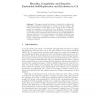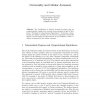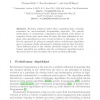4 search results - page 1 / 1 » Integer Gradient for Cellular Automata: Principle and Exampl... |
SASO
2008
IEEE
13 years 11 months ago
2008
IEEE
—When programming a spatial computing medium such as a cellular automaton, the hop count distance to some set of sources (particles) is an often used information. In particular, ...
ACRI
2004
Springer
13 years 10 months ago
2004
Springer
Abstract. This paper reviews the history of embedded, evolvable selfreplicating structures implemented as cellular automata systems. We relate recent advances in this field to the...
MCU
2004
13 years 6 months ago
2004
The classification of discrete dynamical systems that are computationally complete has recently drawn attention in light of Wolfram's "Principle of Computational Equivale...
UPP
2004
Springer
13 years 10 months ago
2004
Springer
Evolving solutions rather than computing them certainly represents an unconventional programming approach. The general methodology of evolutionary computation has already been know...



